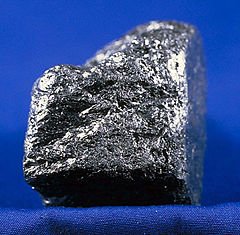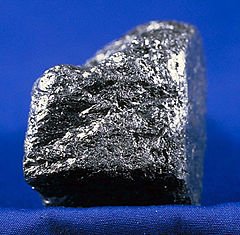
Graphite Creek is an active prospect and proposed graphite mine on the Seward Peninsula, adjacent to Grantley Harbor near Teller, roughly 40 miles north of Nome. Graphite Creek is currently being explored by Graphite One Resources. Graphite Creek is near Port Clarence, a proposed location for building the U.S.’s first deepwater arctic port. A deepwater port at Port Clarence would presumably make the Graphite Creek mine much more economically viable.
Uses of Graphite
Graphite is not a metal. It is a type of molecular carbon, which is mined in a way similar to metal, and often used in similar ways (as compared to hydrocarbons like oil, coal, and natural gas, and to quarried bulk minerals like gravel and salt). Graphite is a strategic resource, and the United States is currently 100% reliant on imports. Most graphite is currently mined in China, which is consolidating its graphite industry, potentially leading to a global supply crunch.
Graphite mining can be thought of as more analagous to the mining of gemstones (and indeed, diamond is another form of molecular carbon). It is the arrangement of the carbon atoms into useful molecules which makes graphite valuable.
Graphite has a wide variety of uses, including in pencil “lead” (actually graphite and a clay binder), dry lubricants, crucibles, electrodes, automobile brake pads, lithium ion batteries, and as a carbon raiser in steelmaking. It is particularly valued for remaining stable and durable at extremely high temperatures. More exotic uses include in radar-absorbent (stealth) materials, as a potential feedstock for manufacturing carbon nanotubes and graphene, and as a neutron moderator in nuclear reactors.
Graphite is in increasing demand to make lithium ion batteries. Tesla’s lithium ion battery “gigafactory” is expected alone to drive an major expansion in graphite mining.
Graphite Mining
Graphite can be extracted using either surface (open pit) or underground mining methods, such as block caving. In the ground, graphite is chemically separate from but distributed throughout the host rock (called “gangue”), unlike in many valuable metal ores, in which the metals are chemically bound into minerals. The graphite must still be physically removed from the host rock. This can be done either mechanically, by grinding the rock into powder and using multiple flotation cycles, or chemically, by using acid.

Graphite mining does not inherently create long-term hazardous wastes, acid drainage, or perpetual storage concerns. However, some graphite is found in sulphide ores, which can create acid mine drainage. The hazard posed by the wastes at Graphite Creek would depend on the composition of the gangue (host rock), and whether it releases hazardous byproducts when ground into tailings. Acid extraction of the graphite would increase the potential hazard of the wastes and possibly require water treatment, as acids would leach heavy metals and other solubles as well as graphite from the slurry.
Regardless of rock chemistry, the mine tailings would need to be kept isolated from the environment to prevent the release of particle plumes that could harm or kill aquatic life. The threat posed by muddy wastes of chemically inert rock is, however, relatively minor compared acid-generating or toxic wastes, which must be perpetually isolated. Storage and management of non-acid wastes is comparatively easy - though facility breaches can cause severe local damage (exemplified by Mount Polley, BC, which released non-acid wastes).
Local Response
Local respone has been mixed. Local residents have acknowledged that a mine may bring jobs and cash income, but also that it may impact subsistence resources, particularly fish and seals. The same concerns surround the proposed Port Clarence deepwater port.
Current Status
Graphite One Resources has applied for an exploration permit to continue its geological investigation of the area (see Alaska DNR online announcement.)
Created: Jan. 19, 2018